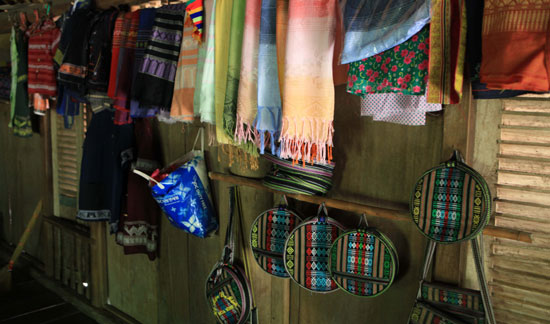The Muong ethnic minority people in the northern mountainous province of Hoa Binh persist in preserving unique traditional values of both tangible and intangible heritage.

Giang Mo village, surrounded by vast green forests, is ideal for people to escape from the constant noise and traffic congestion of cities.
Located in Binh Thanh commune, Cao Phong districts, some 12km from Hoa Binh City, the village leans against Cham Mountain, with small houses built on stilts along the Cai stream.
A winding paved road takes visitors to the local Muong community with a total of more than 100 houses on stilts, which has become a popular destination for tourists.
At first sight they are in all impressed by the friendly and hospitable smiles appearing on the face of villagers, who say, "Please climb up to have a cup of tea with us!"
Tourism services have gradually improved the living conditions of Muong villagers but their traditional lifestyle and customs remain with the passage of time. On this account, the village has been considered as a Muong culture centre.
Along with intangible heritage like songs, dances and other cultural values, the Muong families keep very old things like water pipes, rice mortars (powered by water stream), crossbows and farm tools, mostly made of natural materials like timber and bamboo. Some families still weave cloth with traditional looms and hope to hand down the skills of making colourful brocade items to next generations.
Villager Dinh Van Duc says they receive guests everyday and treat them with tea, wine, fruit and rice cakes.
According to village chief Nguyen Hau, Muong villagers began to develop tourism services in 1995.
"After the Hoa Binh Hydro-electric power project got off the ground, our village has become a tourism destination," he says.
Another villager, Nguyen Thi Mai, says, “We still live on farming. While many men go to work far from home, women and children stay to receive tourists.”
Our stilt houses are different from those of the Thai and Tay," she says.
Hau’s 80sq.m house on stilts has a thatch roof, with four main pillars made of 6m-high chò (parashorea) trunks. Its beams have decorative images based on Muong legends. Under the roof is an altar for Heaven and ancestors.
He says the village has 111 households in which 40 families provide tourism services.
From October to the next April, the village receives about 1,000 international and domestic tourists each month," he adds.
Luckily, each corner of the village remains in good shape. On the walls, people hang gongs, two-chord fiddles, flutes, and animal heads. Many things are old but have been carefully preserved by their owners.
The village has its own regulations to protect the Muong against social ills and encourage them to preserve their traditional wooden houses.
In recent years, many families have restored their traditional brocade weaving and knitting crafts.
Beautiful items are hung tidily on the walls for visitors to touch and take photos; if they want to purchase any items they will be given a generous discount by family members.
They like visitors to taste traditional dishes like steamed sticky rice, chicken served with sour bamboo shoots, boiled pork laid on banana leaves, and rice wine.
The most exciting moment comes when the house owner plays the vertical flute over a bottle of wine made from bananas, or a jar of Can (sweet rice wine), that people drink through long bamboo tubes.
Children like to take foreign visitors to a large wooden house, where the village's art troupe performs folk songs and dances.
"Although I don't understand the Muong language, I think the melodies are beautiful," says Francois d’Alzon, a French tourist.
"Everyone is open-hearted and friendly, and the air so fresh that if I decide to settle down here I will live to the age of 100," he says with a broad smile.
“Foreign tourists love the village so much. Some French have offered money to villagers to help build our 700m-long paved road," says the village chief.

Leave your comment on this story